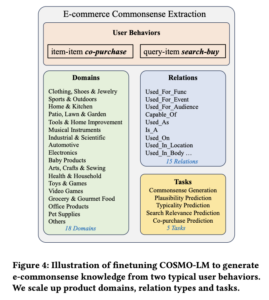RUFUS, Amazon’s new shopping assistant, promises to enhance the Amazon shopping journey by providing customers personalized recommendations and streamlined navigation. This tool reflects Amazon's commitment to leveraging AI to gather customer insights and product information to tailor the shopping experience to individual preferences and behaviors. RUFUS will be accessible across SERPS and PDPs for all shoppers soon.
However, it's COSMO that truly captures our attention. From a recent publication from researchers at Amazon, COSMO is a newly integrated AI tool impacting Amazon’s search algorithm. Described as a scalable system for mining user-centric common sense knowledge, COSMO can also revolutionize Amazon search navigation, moving away from traditional product-centric taxonomies towards a customer focused approach. This shift enhances the shopping experience, aligning it more closely with customer intents and behaviors, and bridging the gap between product classification and customer language by dynamically providing taxonomy with customer query concepts.
In other words, COSMO places preference on a customer’s intent and demographics to determine which results are shown in the SERP. No need to panic - yet. Amazon has not officially announced any major updates to their A9 algorithm, but did report that COSMO has been in testing across 10% of US traffic recently. While it might not be tomorrow, COSMO is the future of organic search on Amazon, and brands should react accordingly.
How COSMO Works and What it Does
So how does COSMO work? For example, say you are looking for “men shoes for wedding.” With COSMO, the algorithm knows you’re looking for hard bottom shoes. Where traditional search engines would fail to recognize this connection, COSMO utilizes common sense knowledge to strengthen search relevance, providing better recommendations in-line with the shopper’s intentions.
This new AI leverages extensive behavioral data and constructs industry-scale knowledge graphs to understand user intentions. COSMO infers customer intent via a training cycle where a Large Language Model (LLM) makes predictions, gets feedback, and uses the learnings to improve predictions moving forward.
By also incorporating data captured by RUFUS, COSMO will analyze what your product does, customer needs, and how customers use your product. Amazon science explains the functionality: "If a customer, for instance, submits a query for ‘shoes for pregnant women,’ the recommendation engine should be able to deduce that pregnant women might want slip-resistant shoes. We’re building a knowledge graph that encodes relationships between products in the Amazon Store and the human contexts in which they play a role — their functions, their audiences, the locations in which they’re used, and the like. For instance, the knowledge graph might use the used_for_audience relationship to link slip-resistant shoes and pregnant women."
Code3 Senior SEO Strategists note Amazon has always had those "audience" fields, but never have we seen them appear in the sidebar of the SERP or PDP cases. We have always recommended to clients to fully complete these fields, but now that COSMO has been announced, it’s even more critical to ensure they’re complete as we identify "context" for products.
COSMO’s workflow examines specific functions to make a match, including "used for," "used on," "used with," "interested in," and "capable of." When downloading a product template, we can see “discovery” attributes per category. Attributes such as “subject,” “target audience,” and “included components” pertain to the exact functions that the workflow utilizes to understand what your product does and how customers use it.

How does COSMO Impact Amazon Organic Search?
While Amazon has not officially announced major updates to the A9 algorithm, COSMO has already been tested across 10% of US traffic in previous months. In fact, “an 8% increase in navigation engagement rate was observed within the same traffic segment, highlighting improved customer interaction and satisfaction.”
Code3’s SEO Strategists predict that COSMO will be further integrated within the next year (Amazon Accelerate is just a few months away!). Once this integration occurs, COSMO’s logic is expected to align search queries more closely with shopper intent, resulting in more personalized and refined search results. It’s safe to say this is a significant, game-changing update to organic search on Amazon, resulting in a better shopper experience.
But what about keywords? Traditionally, Code3 SEO Strategists optimize Product Detail Pages (PDPs) using high search volume and relevant keywords to ensure the A9 algorithm indexes and displays our listings in search results. With COSMO, this process will undergo significant changes. COSMO continuously learns from past searches and makes predictions, making customer intent and context a key ranking factor, potentially more important than exact-match keywords.
Keyword research is evolving into persona and shopper research. While our keyword research tools remain essential for understanding how shoppers search, we also need to incorporate research methods that analyze reviews, returns, and audience behavior. This will provide the algorithm with the initial insights needed to make further contextual connections.
What Should Brands Do About It?
From a PDP perspective, the implications are clear. As Amazon expands its knowledge graphs to incorporate common sense knowledge, PDP information must be descriptive, clear, and precisely aligned with shopper intentions. This entails understanding how shoppers find and interact with your products and ensuring that PDPs address their needs.
As Amazon’s knowledge graphs evolve over time, the correlations between a shopper's intent, search queries, and product listings will become more accurate, ultimately enriching the overall shopping experience on the platform. Brands must consistently educate the algorithm about their products by answering key questions customers have about their products and incorporating relevant keywords that resonate with their customers. Integrating this data will enable the system to recognize your product best fits the dataset.
Key Takeaways
While COSMO isn’t completely integrated, there is no doubt it will be, and there are plenty of things brands can start doing now so they’re prepared when it rolls out. Our SEO Strategists recommend:
- Know Your Customer – Utilize audience data to understand who your customers are on Amazon and their preferences.
- Consistently Optimize & Refine Your Product Listings – Stay on top of trends and customer preferences to integrate these insights into your product titles and descriptions. Be sure to answer key functions such as what is the product used for and who is the audience.
- Focus on Product Attributes Completion – Download your category listing report and ensure your listings match the best product type. Verify that all attribute values are both complete and accurate to enhance visibility.
- Reviews are King – Encourage customer feedback. This information will provide more insight on your products and how your customers interact with them.
At Code3, we're not just observers; we're actively engaged in understanding and leveraging these advancements to drive success for our clients. By staying informed about the latest developments in AI technology, particularly within e-commerce platforms like Amazon, we're able to tailor our strategies to capitalize on these innovations.

